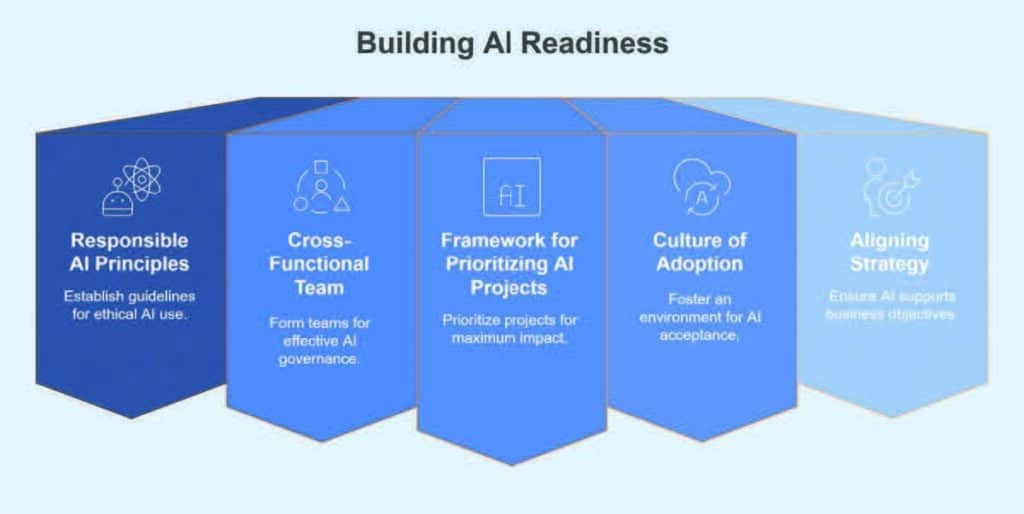A STEP-BY-STEP GUIDE
By Steve Krushelniski, Founder of The Extra 20
The energy sector stands at a pivotal crossroads
Companies that effectively harness artificial intelligence gain significant competitive advantages, while those that delay risk falling behind. Yet, for many companies, the path to AI adoption remains unclear.
We’ve identified an approach to AI implementation that can increase both success and impact while focusing on increasing adoption. Here’s a step-by-step guide to building an AI-ready business:
1. Principles for Responsible, Safe AI Practices
In our polling, we found out that many employees are secretly using AI tools without the knowledge of their employees. This shadow use of AI can negatively impact your business, so it is essential to establish clear boundaries before implementing any AI solution.
Responsible AI is about protecting your data while improving your business.
Ask yourself: Are employees already using public AI tools like ChatGPT with company data without oversight? How will we ensure data privacy and security in our AI implementations?
Creating a foundation of responsible AI helps prevent costly missteps and builds confidence across the organization. Many companies have discovered that unauthorized AI use is already happening, with employees inputting sensitive information into public tools. Addressing this shadow use while ensuring transparency establishes the groundwork for safer, more effective AI adoption.
2. Building a Cross-Functional Team for AI Governance
Effective AI governance requires cross-functional teams to structure dialogue across the organization to help mitigate risks and outline responsibilities.
Ask yourself: Who should be accountable for AI systems within our organization? How can we involve stakeholders from different departments in governance discussions?
Companies that establish cross-functional AI governance committees early avoid siloed AI development. This collaborative approach ensures that technical implementation aligns with operational needs while addressing legal, ethical, and customer experience concerns.
3. Framework for Prioritizing AI Projects
Not all AI initiatives deliver equal value. A structured prioritization framework helps focus resources on projects with the highest impact potential.
Ask yourself: Where are the “low-hanging fruit” opportunities that could deliver quick wins? How can we balance technical complexity with expected ROI?
The most successful companies begin with narrowly defined projects that address specific operational challenges rather than attempting enterprise-wide transformation.

4. Creating a Culture of AI Adoption
Many AI initiatives fail to deliver ROI not because of technical shortcomings but because of insufficient attention to the human elements of adoption. Successful AI implementation requires a deliberate focus on change management and user experience.
Ask yourself: How can we design AI solutions with the user’s needs at the center? How can we make adoption intuitive rather than disruptive to existing workflows?
Look for ways to integrate AI agents with existing systems rather than wholesale changes. By doing so, organizations allow users to maintain familiar workflows while gaining enhanced capabilities. This approach minimizes resistance while accelerating time-to-value, ensuring AI projects demonstrate tangible ROI.
5. Aligning AI with Strategy
For AI to deliver sustainable value, it must directly support your core business strategy rather than existing as a separate technological initiative.
Ask yourself: How do our AI initiatives connect to our business goals? What specific KPIs should we use to measure success?
Companies that see the greatest returns from AI have integrated it into their strategic planning processes, ensuring that technology investments directly support business objectives.
Looking Ahead
The companies that thrive will not necessarily be those with the largest AI budgets but those that methodically build AI-ready foundations. Companies can unlock AI’s potential by establishing responsible principles, implementing effective governance, prioritizing high-impact projects, and aligning with business strategy.
The question isn’t whether to embrace AI—it’s how to do so in a way that drives sustainable growth while managing inherent risks. Companies that answer this question effectively will power the next wave of innovation. If you have any questions, please get in touch with us.
Steve Krushelniski is the CEO of The Extra 20, a growth partner for companies in Alberta focused on helping businesses reach the next level through pragmatic, collaborative approaches to sales, operations, and AI adoption.
Originally published in IGNITE V10.




